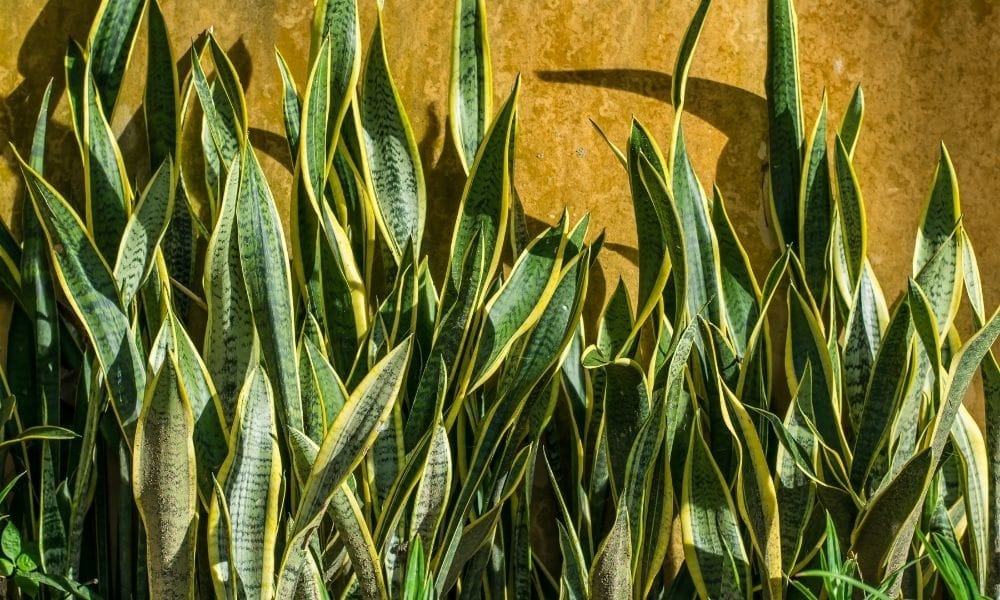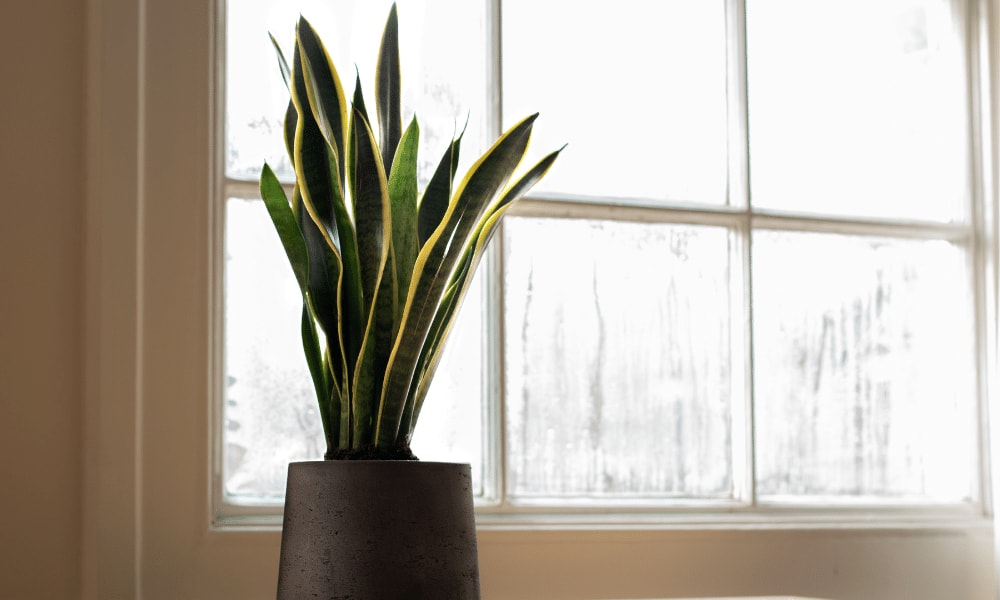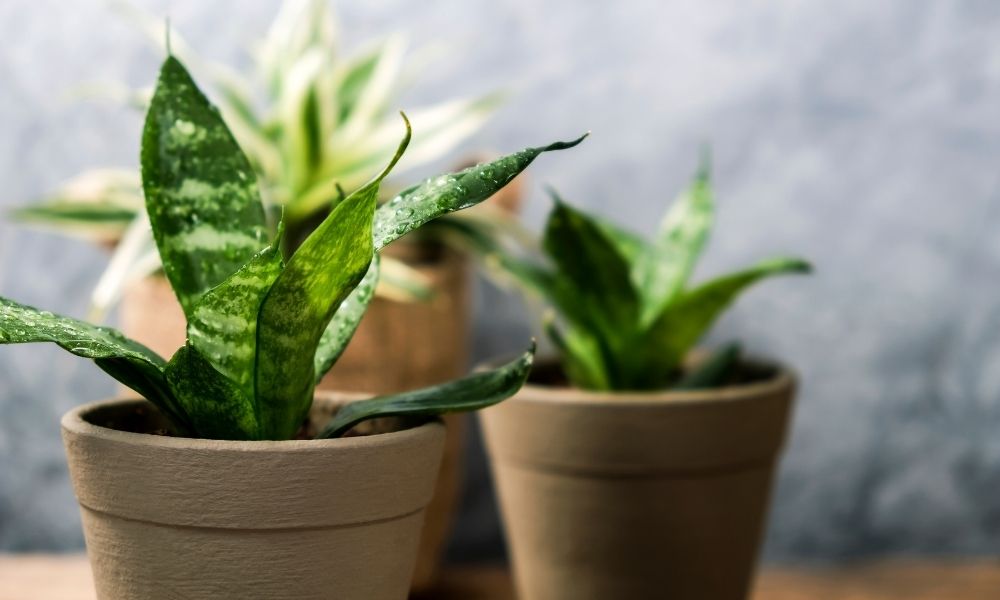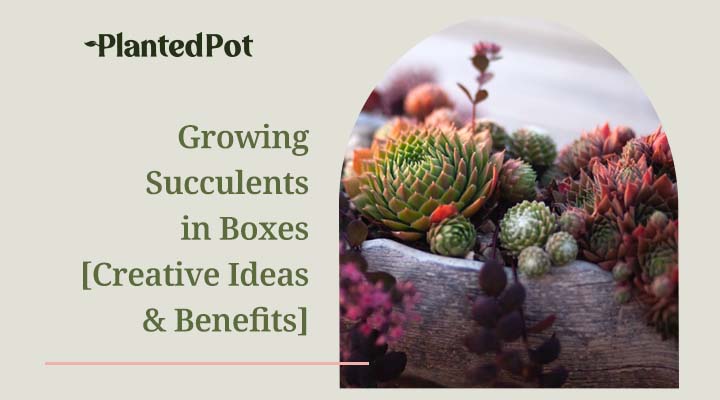
Snake Plant Care: The Complete DIY Grower’s Guide
Home / Snake Plant Care: The Complete DIY Grower’s Guide

Snake Plant Care: The Complete DIY Grower’s Guide
When your apartment is small and a bit darker you can sometimes figure taking care of indoor plants isn’t for you. But that all changes with the Snake Plant! Snake Plant care is actually super easy! This low-maintenance succulent plant doesn’t require a ton of sunlight or water, making it the perfect starter plant for beginners.
But the Snake Plant isn’t only hardy and versatile. It’s also beautiful, with its long, powerful green leaves and gold lining. It can boost the decor points of any living room. It’s also the perfect bedside companion, thanks to its amazing air purification prowess.
There’s no reason NOT to have one or two Snake Plants in your home! Let’s go over a bit more about what maintenance is required to make sure your Snake Plant is looking gorgeous and healthy so it can stick by your side for decades.
What is a Snake Plant?
The Snake Plant is one of the most adaptable and robust houseplants you’ll ever come across. Its durability is unmatched, making it perfect for first-time plant owners and apartment dwellers with a lack of light and other resources. No matter the hardship, this member of the Lily Family will provide a striking architectural shape thanks to its bold foliage design and a pleasing green and yellow color combination that boosts the decor points of any space.

Why Is it Called a Snake Plant?
The Snake Plant, also known as the Mother-In-Law’s Tongue, is most distinguished by its sharp leaves. While the rigid green leaves outlined in yellow can definitely resemble a snake, that’s not the only reason the plant earned this name. The tough foliage is also said to dissuade snakes from approaching. As we said, this is one badass, durable plant.
Do Snake Plants Have Any Benefits?
The Snake Plant is one of several plants NASA chose to study for its powerful air purification abilities. It’s known to combat “sick building syndrome, a condition where people suffer from illness-like symptoms from the building in which they work or live. The Snake Plant, or Sansevieria, is great for offices, warehouses, and trade buildings where chemical products are produced and used.
Another study by the Department of Horticulture at the University of Georgia and the Institute for Environmental Research at Yonsei University in Seoul, Korea found that the seemingly simple Snake Plant actually removed formaldehyde and benzene from the air.
NASA recommends having 15 to 18 medium-to-large size Snake Plants for a 1,800 square-foot home. While you may not have room for that many Snake Plants, there’s no denying the benefit of having one or two of these hardy plants around!
Make sure to always have one in your bedroom. While most plants uptake carbon dioxide (CO2) and release oxygen during the day, the Snake Plant does its photosynthesis process during the night.
It’s been proven that a person could survive in a completely air-sealed room with no problem if they have six to eight Snake Plants in the room with them.
Where Are Snake Plants From?
Sansevieria was first cultivated in China, where it was kept as a treasured houseplant. Families believed that those who grew the Snake Plant would be bestowed long life, prosperity, intelligence, beauty, art, poetry, health, and strength by the eight gods.
The Snake Plant is native to southern Africa. Because of this, they are well adapted to conditions similar to those in the southern states. If you live in an area with warmer weather, the Snake Plant can be grown outdoors as well. But they may become invasive so you should keep them in contained areas or pots.
How Long Does a Snake Plant Live?
The average life expectancy of a Snake Plant given proper care is five to 10 years. But some have been known to live for 25 years! Snake Plants grow very slowly. They will grow fragrant light green or yellow flowers in the right conditions, but flowering remains unpredictable.
How to Care for a Snake Plant
If you are new to keeping plants, the Snake Plant is the perfect start for you! The Snake Plant is one of the most low maintenance indoor plants available. Many people say you have to TRY to kill this durable houselpant. Lack of water and lack of sunlight won’t stop this plant from thriving. But if you want to offer your Snake Plant the best care possible, we have some advice below to keep your plant bright and strong.
Planter Type
The best planter type for a Snake Plant is terra cotta pots. That’s because they allow the soil to dry out a lot more easily than plastic pots. This proud plant prefers to grow in a slightly small pot.
They’ll grow quicker this way because they prefer a crowded root system. They don’t need a deep pot because they like to spread out as they grow instead of downward.
Always repot your Snake Plant by going up one pot size (like 6″ to 8″). While the Snake Plant likes a tight pot, they will break the container if they outgrow it.
Use a well-draining potting mix in the terra cotta pot — one for cacti and succulents will work great for the Snake Plant, too. Together, the pot and soil will be more resistant to becoming oversaturated with water. An overwatered Snake Plant will start to become soggy, brown, and wilted.
Watering
The Snake Plant doesn’t need to be watered frequently. In fact, it’s recommended that you DO NOT water this plant a lot. Before watering, always check to make sure the soil is dry. You can use a toothpick to see if the soil below the surface is moist. Hold off on watering if you see or feel any moisture.
You’ll notice during the winter that the Snake Plant isn’t actively growing. You can water it even less during the months where the Snake Plant isn’t visibly growing.
Water from the bottom of the pot if you can. This encourages the Snake Plant’s roots to grow downwards and deep. This will ensure they are more stable since their leaves can grow quite tall and thick.
Overwatering can result in root rot. Here’s how to tell if your Snake Plant is overwatered:
- Soggy leaves from holding in too much water
- Leaves becoming yellow and shriveled
- Some leaves start to droop
- Roots are darkish brown and feel soft
- Soil is full of fungus and mold
You can save an overwatered Snake Plant if it’s early enough in the process and their roots are not fully rotted. Remove the entire plant from the pot and then place the root ball on newspaper. Protect any living roots that are left. Use paper towels to dry off the roots, removing most of the water. Lay the plant in the shade for three to five days after this process. Cut off the damaged parts and then prepare a new pot for your Snake Plant. Not every Snake Plant will survive being overwatered but you can always try!
Lighting for Snake Plants
Snake Plants prefer to be in bright, indirect light. They can tolerate some direct sunlight if harsh light can be filtered. But they often prefer to grow in shady corners and other low-light areas (just not in the complete dark). Keep this in mind while picking a location for your new plant pal.
Even though the Snake Plant prefers to not be in direct sunlight, you’ll notice that it grows slower and develops less color if it’s not receiving enough light to properly thrive. If your Snake Plant seems droopy it means it may have been in the dark for too long.
How Cold Can Snake Plants Tolerate?
The area you choose should also have a temperature above 50 degrees. A temperature range between 70 and 90 degrees is best. The Snake Plant prefers to be in a warm location. If you live in an area where the winter gets cold, move the Snake Plant away from drafty windows.
This versatile plant can thrive in a dry or stale room, like a small office. It can also do well in a bathroom despite the higher humidity.
Regular Maintenence
Due to the shape, size, and texture of the Snake Plant’s leaves, you might notice that they get dusty! Use a duster to lightly remove dust off of your Snake Plant when you notice dust building up. You can also use a damp cloth.
Can You Trim a Snake Plant?
While they grow slow, the Snake Plant can reach an impressive height if you let them. Many get well over four feet tall. The plant will also spread outwards as new leaves sprout up. The Snake Plant will have to be trimmed at some point to keep it tidy and make sure they are healthy.
Inspect your plant for signs of damage. Also, keep an eye on their shape and size. Use a sharp, sterile pair of pruners to cut off your chosen leaves. You can also use a sharp knife if preferred. Make sure you’re cutting them at the soil line.
You can prune a Snake Plant any time of year. This is a durable and slow-growing plant that will tolerate pruning whenever you feel it’s necessary. But it’s always best to prune them when the plant is actively growing, so in the spring or early summer.
If your Snake Plant isn’t in the best health, pruning will put them under stress. Improve your plant’s health first before trimming by encouraging new growth.
Should I Cut Brown Tips Off Snake Plant?
Removing damaged parts of your Snake Plant is one of the common reasons to prune it. While their leaves can last for years, the damage that develops will stay on the leaves permanently. Damage can happen from excessive sun, overwatering, or pests.
Prune off any leaves that are unsightly or damaged. New leaves will sprout out to replace them, keeping your Snake Plant healthy and making sure they look striking and visually stunning.

Repotting Snake Plants
In good conditions, the Snake Plant will need to be repotted annually. While they grow slow, they like smaller pots which means their roots will soon break the pot if they aren’t given enough room to spread properly.
The best time of year to repot the Snake Plant is in late winter or early spring. This is when the plant isn’t actively growing.
You’ll know it’s the right time to repot your Snake Plant when roots are visibly coming out the drainage holes of the pot. Certain pots might even begin to bulge. The plant itself may also seem stuck, meaning its home is getting a bit too tight.
Keep in mind that the Mother-In-Law Plant can be quite top-heavy thanks to its leaves!
- Pick a pot that’s wider than it is deep so the plant won’t tip over.
- Find a pot that’s about 2″ wider than the current pot — you don’t want to increase the size too drastically.
- Fill the new pot with well-draining soil meant for tropical houseplants.
- Remove the Snake Plant from its current home. Keep a close eye on the root ball, handling it with care. Examine the roots and cut away any rotten portions. They will be brown and soft. Make sure there are no large roots wrapped around the entire ball. Those might stop the other roots from growing further.
- Set the plant on top of the potting mix in the new terra-cotta pot. The plant should be within two inches of the pot’s rims and not planted deeper than it was previously. You can remove or add soil to make sure it’s the right depth.
Common Snake Plant Care Issues
The Snake Plant is known for being quite hardy and versatile. Still, there are some things to look out for if you want to make sure it’s as healthy as possible.
- Leaves curling or falling over: One of the most common reasons this happens to Snake Plants is thrips, a small black insect. They will infest the Snake Plant, eventually killing it. Remove damaged leaves and then wipe the plant down with a moist, clean cloth. Spray the plant with neem oil a few times a week for a month.
- Overwatering: If there are no signs of bugs, the curling leaves might be caused by being watered a bit too much. The plant might be weighed down. Overwatering will also cause leaves to be soggy or mushy.
- Dry and brown tips: You might not be watering your Snake Plant enough! This is a durable plant but it still requires some watering when the soil is completely dry.
- No growth: Snake Plants are very slow growers, especially in low-light conditions. But if you notice your plant seems small in stature and dull in color, try moving it to a spot with a bit more indirect sunlight. You can also try a small amount of fertilizer — just be careful because it can make the soil moister.
- Cracked leaves: Cracked leaves are quite normal for the Snake Plant. Don’t worry too much about it!

Snake Plant Varieties
All Snake Plant varieties are succulents that grow very well inside. They all require little maintenance and are considered quite hardy. We have been telling you all about the Sansevieria trifasciata, also known as the Mother-In-Law’s Tongue. But we have some other popular variations here to consider:
- Sansevieria Trifasciata ‘Black Gold’ (Viper’s Bowstring Hemp): A popular perennial with dark green leaves and yellow accents. It often grows up to 35″ tall and can sometimes sprout small flowers in the summer. This is the variety NASA recommends!
- Sansevieria Trifasciata ‘Futura Robusta’: An evergreen with gray-green striped leaves. It’s shorter than other varieties but is just as durable.
- Sansevieria Trifasciata ‘Twisted Sister’: The name of this variety comes from the plant’s curled leaves. It can sometimes resemble a bird nest.
- Sansevieria Trifasciata ‘Golden Hahnii’: A dwarf variety, the leaves form clusters as they grow. The shape is a rosette pattern. They grow only 12″ high.
- Sansevieria Trifasciata ‘Futura Superba’: With bright green leaves and gold edges, this looks like the Mother-In-Law’s Tongue but with shorter and wider leaves. They don’t mind a little less sun and a little less space.
Final Thoughts – Snake Plant Care
If NASA recommends you have, like, 20 of these plants, why WOULDN’T you? But on a serious note, the Snake Plant is the perfect addition to any home, especially dimly lit apartments that need an extra boost of color and fresh air. There’s no denying the power of this plant’s air purification skills and the boldness of its leaves.
As you can see, the Snake Plant is the perfect companion for new plant owners looking for easy-to-care-for plants or expert growers who want to enjoy the addition of a simple, hardy plant. With its bold, colorful leaves, the Snake Plant is an exciting accent to any room — and it will improve the air quality simultaneously!
While this plant is easy to take care of, just make sure to keep up with watering and give your Snake Plant a comfortable spot in the home to make sure they stay bright and healthy.



